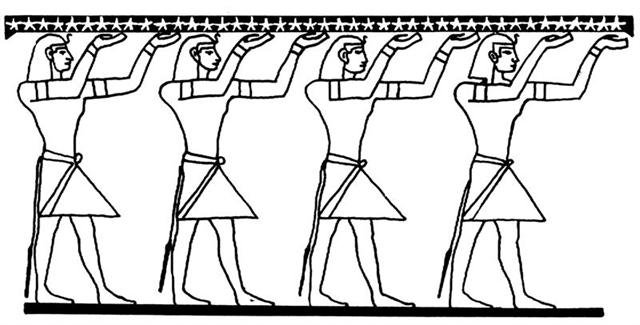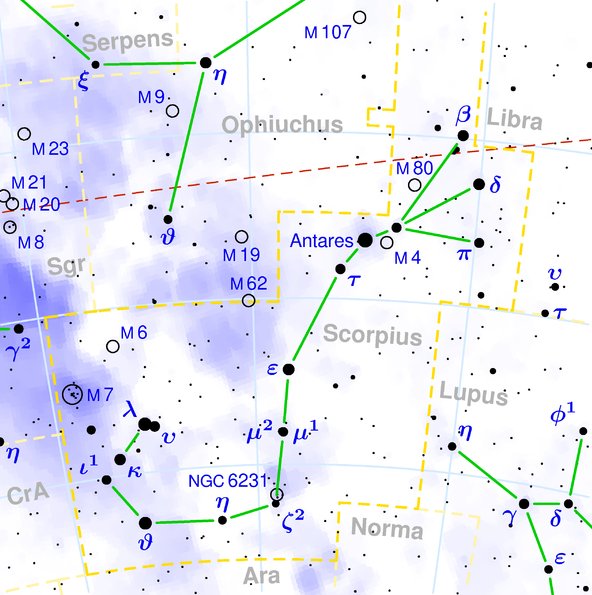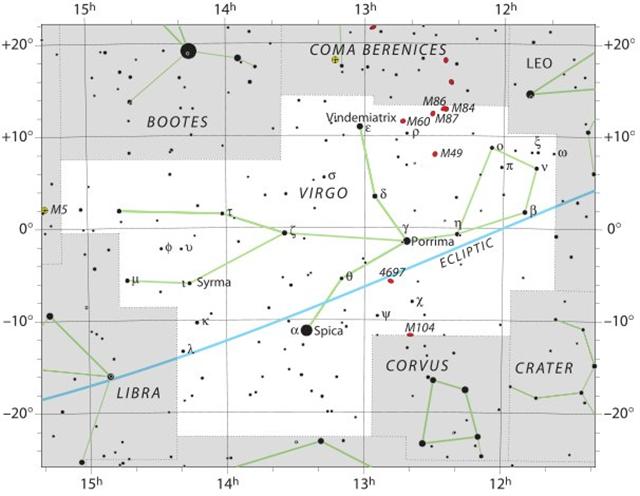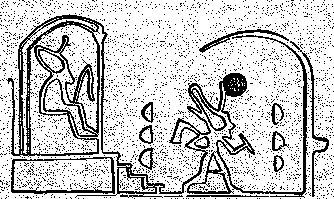Then there was the problem of how to accomodate the fact that the Sun year was slightly longer than 360 days. A year measuring 360 regular days with 5 extra was considered: ... Nut, whom the Greeks sometimes identified with Rhea, was goddess of the sky, but it was debatable if in historical times she was the object of a genuine cult. She was Geb's twin sister and, it was said, married him secretly and against the will of Ra. Angered, Ra had the couple brutally separated by Shu and afterwards decreed that Nut could not bear a child in any given month of any year. Thoth, Plutarch tells us, happily had pity on her. Playing draughts with the Moon, he won in the course of several games a seventy-second part of the Moon's light with which he composed five new days. As these five intercalated days did not belong to the official Egyptian calendar of three hundred and sixty days, Nut was thus able to give birth successively to five children: Osiris, Haroeris (Horus), Set, Isis and Nepthys ... But 364 / 4 = 91 = 13 weeks was evidently a more acceptable solution. This was easy to use for counting the distance from one of Sun's cardinal points to another. 360 / 4 = 90 days and then a supporting extra day would come in before next regular sequence of 3 * 30 days.
... Among the multitude of gods worshipped by these people were four whom they called by the name Bacab. These were, they say, four brothers placed by God when he created the world at its four corners to sustain the heavens lest they fall ... ... In the ms. Ritual of the Bacabs, the cantul kuob [the suffix '-ob' indicates plural and ku resembles the Polynesian Ku], cantul bacabob, the four gods, the four bacabs, occur constantly in the incantations, with the four colors, four directions, and their various names and offices ... This connects up the present section with the beginning of the 'sacred tonalamatl', at the Spring equinox with the Mayas as with the Mexicans, and in the center of the 364-day year (52 days of which preceded and 52 followed the tonalamatl or tzolkin), ruled by its 91-day quarters by the Four Bacabs, whose quarternary repetition (in the 1820-day period) we have thus verified ... ... 1820 = 20 * 91, i.e. the bacabs circulated 5 times in the 1820-day period, 5 * 364 = 1820, and 7 * 260 also happens to be 1820. They were ruling the 4 quarters of a 364-day long year, and in the center of this year there were 260 days, the sacred tonalamatl (tzolkin) calendar, which began at spring equinox:
In the G text there is one place where 4 glyphs in a sequence ought to be considered as the corresponding sky proppers as viewed from south of the equator:
These 4 'bacabs' (Ku-ob) were not standing straight and they could have been designed as curved in order to imitate the shape of Antares (the Scorpion) - also represented by Hotu A Matua.
... According to an etiological Hawaiian myth, the breadfruit originated from the sacrifice of the war god Kū. After deciding to live secretly among mortals as a farmer, Ku married and had children. He and his family lived happily until a famine seized their island. When he could no longer bear to watch his children suffer, Ku told his wife that he could deliver them from starvation, but to do so he would have to leave them. Reluctantly, she agreed, and at her word, Ku descended into the ground right where he had stood until only the top of his head was visible. His family waited around the spot he had last been day and night, watering it with their tears until suddenly a small green shoot appeared where Ku had stood. Quickly, the shoot grew into a tall and leafy tree that was laden with heavy breadfruits that Ku's family and neighbors gratefully ate, joyfully saved from starvation ...
But south of the equator the entrance pillar (Ana-mua) was Antares and at the time of the Bull this star would have been at the southern spring equinox:
Aldebaran was straight (male), but not Antares. ... Freeman describres the dualistic cosmology of the Pythagorean school (-5th century), embodied in a table of ten pairs of opposites. On one side there was the limited, the odd, the one, the right, the male, the good, motion, light, square and straight. On the other side there was the unlimited, the even, the many, the left, the female, the bad, rest, darkness, oblong and curved ... There had to be a sex exchange between Aldebaran and Antares. And thus there must have been another such (and opposite) sex exchange between Antares and Aldebaran. The first probably occurred at Heze, at the beginning of line Ga6, at the time when the second, at Alseiph, was at the Full Moon:
... My son, said Makea tutara one evening at dusk, when they were sitting outside the house, I have heard from your mother and from others that you are brave and capable, and that in everything you have undertaken in your own country you have succeeded. That says a great deal for you. But I have to warn you: now that you have come to live in your father's country you will find that things are different. I am afraid that here you may meet your downfall at last. 'What do you mean?' said Maui. 'What things are there here that could be my downfall?' 'There is your great ancestress Hine nui te Po', said Makea, gravely. And he watched Maui's face as he mentioned the name of Great Hine the Night, the daughter and the wife of Tane and goddess of death. But Maui did not move an eyelid. 'You may see her, if you look', Makea went on, pointing to where the sun had gone down, 'flashing over there, and opening and closing, as it were'. His thoughts were on death as he spoke. For it was the will of Hine nui, ever since she turned her back on Tane and descended to Rarohenga, that all her descendants in the world of light should follow her down that same path, returning to their mother's womb that they might be mourned and wept for. 'Oh, nonsense', said Maui affectionately to the old man. 'I don't think about that sort of thing, and you shouldn't either. There's no point in being afraid. We might just as well find out whether we are intended to die, or to live forever.' Now Maui had not forgotten what his mother once said about Hine nui te Po: that he would some day vanquish her, and death would then have no power over men. He remembered this now, and was not moved by his father's fears. But Hine nui was the sister of Mahuika, and she knew of Maui's dangerous trickery at the abode of fire, and was resolved to protect her other descendants from further mischief of this kind. 'My child', said Makea now in a tone of deep sorrow, 'there has been a bad omen for us. When I performed the tohi ceremony over you I missed out a part of the prayers. I remembered it too late. I am afraid this means that you are going to die.' 'What's she like, Hine nui te Po?' asked Maui. 'Look over there', said Makea, pointing to the ice-cold mountains beneath the flaming clouds of sunset. 'What you see there is Hine nui, flashing where the sky meets the earth. Her body is like a woman's, but the pupils of her eyes are greenstone and her hair is kelp. Her mouth is that of a barracuda, and in the place where men enter her she has sharp teeth of obsidian and greenstone.' 'Do you think she is as fierce as Tama nui te ra, who burns things up by his heat?' asked Maui. 'Did I not make life possible for man by laming him and making him keep his distance? Was it not I who made him feeble with my enchanted weapon? And did the sea not cover much more of the earth until I fished up land with my enchanted hook?' 'All that is very true', said Makea. 'And you are my last-born son, and the strength of my old age. Very well then, be it as it will. Go there, and visit your ancestress if that is what you wish. You will find her there where the earth meets the sky.' And they sat for a while in the dusk, until the red clouds turned grey and the mountains into black. Next morning early, Maui went out looking for companions for the expedition. The birds were up when he left, and among them he succeeded in finding several who were willing to go with him. There was tiwaiwaka, the little fantail, flickering about inquisitively and following Maui along the track as if he might have something for him. There was miromiro, the grey warbler, tataeko, the whitehead, and pitoitoi, the robin, who is almost as tame and curious as the fantail. Maui assembled a party of these friends and told them what he intended to do. They knew it was an act of great impiety to invade the realm of Hine nui te Po with mischievous intentions. And now, they learned, it was Maui's idea to enter her very body. He proposed to pass through the womb of Great Hine the Night, and come out by her mouth. If he succeeded, death would no longer have the last word with regard to man; or so his mother had told him long ago. This, then, was to be the greatest of all his exploits. Maui, who once had travelled eastward to the very edge of the pit where the sun rose, and southward over the great Ocean of Kiwa to where he fished up land, and all the way to the dwelling-place of Mahuika - Maui now proposed a journey to defy great Hine in the west. Taking his enchanted weapon, the sacred jawbone of Muri ranga whenua, he twisted its strings around his waist. Then he went into the house and threw off his clothes, and the skin on his hips and thighs was as handsome as the skin of a mackerel, with the tattoed scrolls that had been carved there with the chisel of Uetonga. And off they went, with the birds twittering in their excitement. When they arrived at the place where Hine nui lay asleep with her legs apart and they could see those flints that were set between her thighs, Maui said to his companions: 'Now, my little friends, when you see me crawl into the body of this old chieftainess, whatever you do, do not laugh. When I have passed right through her and am coming out of her mouth, then you can laugh if you want to. But not until then, whatever you do.' His friends twittered and fluttered about him and flew in his way. 'O sir', they cried, 'you will be killed if you go in there.' 'No', said Maui, holding up his enchanted jawbone. 'I shall not - unless you spoil it. She is asleep now. If you start laughing as soon as I cross the threshold, you will wake her up, and she will certainly kill me at once. But if you can keep quiet until I am on the point of coming out, I shall live and Hine nui will die, and men will live thereafter for as long as they wish.' So his friends moved out of his way. 'Go on in then, brave Maui', they said, 'but do take care of yourself'. Maui at first assumed the form of a kiore, or rat, to enter the body of Hine. But tataeko, the little whitehead, said he would never succeed in that form. So he took the form of a toke, or earth-worm. But tiwaiwaka the fantail, who did not like worms, was against this. So Maui turned himself into a moko huruhuru, a kind of caterpillar that glistens. It was agreed that this looked best, and so Maui started forth, with comical movements. The little birds now did their best to comply with Maui's wish. They sat as still as they could, and held their beaks shut tight, and tried not to laugh. But it was impossible. It was the way Maui went in that gave them the giggles, and in a moment little tiwaiwaka the fantail could no longer contain himself. He laughed out loud, with his merry, cheeky note, and danced about with delight, his tail flickering and his beak snapping. Hine nui awoke with a start. She realised what was happening, and in a moment it was all over with Maui. By the way of rebirth he met his end. Thus died this Maui we have spoken of, who was formed in the topknot of Taranga and cast in the sea, but was saved and nurtured to lead a life of mischief. And thus did the laughter of his companions at the last and most scandalous of his exploits deprive mankind of immortality. For Hine nui always knew what Maui had it in mind to do to her. But she knew that it was best that man should die, and return to the darkness from which he comes, down that path which she made to Rarohenga. Wherefore our people have the saying: 'Death came to the mighty when Maui was strangled by Hine nui to Po, and so it has remained in the world' ... |
|||||||||||||||||||||||||||||||||||||||||||||||||||||||||||||||||||||||||||||||||||||||||||||||||||||||||||||||||||||||||||||||||||||||||||||||||||||||||||||||||||||||||||||||||||||||||||||||||||||||||||||||||||||||||||||||||||||||||||||||||||||||||||||||||












